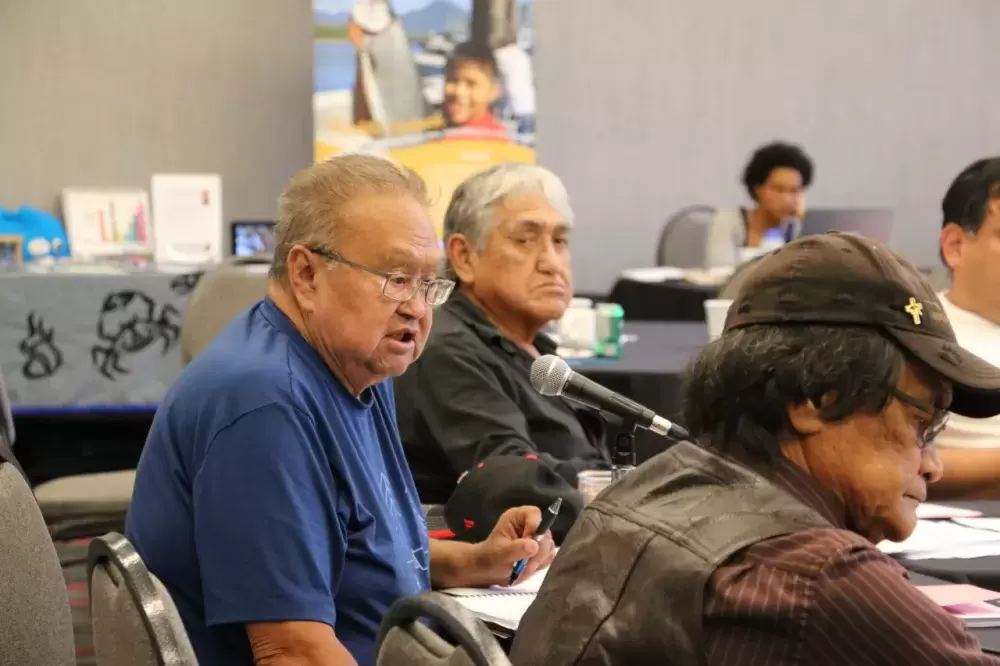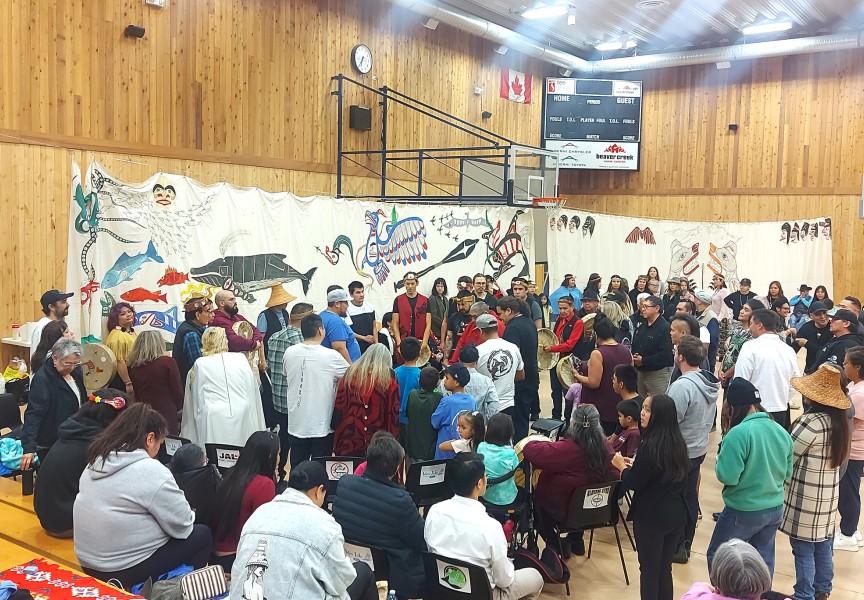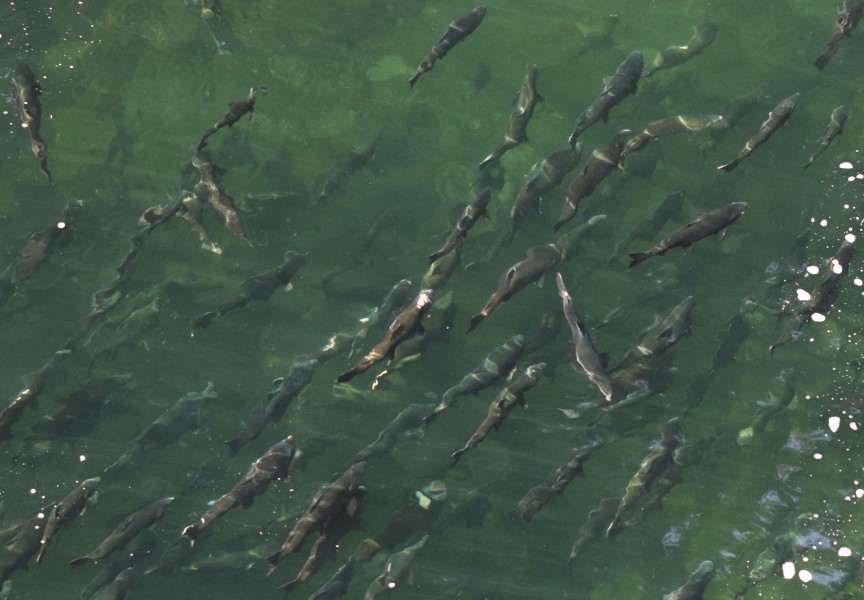First Nations have the right - above other users - to access fish from their waters, according to the Constitution and the Supreme Court of Canada. But this isn’t playing out on the west coast of Vancouver Island, according to Nuu-chah-nulth leaders who addressed the issue at a recent fisheries meeting in Tofino.
Tseshaht Councillor Hugh Braker noted that of the 130,000 chinook that are projected to migrate to the Somass River this spring and summer, 31,000 is allocated for the First Nation’s economic opportunity fishery, while another 2,000 is set aside to Tseshaht’s food, social and ceremonial purposes.
“We have a population of over 1,200, so we can rejoice in getting 1.7 chinook per person for this upcoming year. That’s supposed to be our food, social, ceremonial allocation,” said Braker. “The sport fishermen are getting well over 40,000.”
This frustration was heard around the table from Nuu-chah-nulth representatives at the Council of Ha’wiih Forum on Fisheries, hosted by the Tla-o-qui-aht First Nation June 12-13 in Tofino.
“It offends the constitutional priority of Aboriginal people,” added Braker. “Sport fishermen, commercial seiners, commercial gillnetters, they have no place at the table when my tribe talks about priority for Tseshaht…Our place is guaranteed in the Constitution.”
This year tougher restrictions were imposed on the West Coast in order to protect endangered chinook salmon that originate from the Fraser River. DFO is not permitting the retention of chinook caught west of Vancouver Island until July 15, including for First Nations food, social and ceremonial purposes.
“After conservation, the First Nations fisheries have a constitutionally protected priority and DFO will be authorizing very limited opportunities to harvest chinook for ceremonial purposes prior to July 15,” said Lara Sloan of the department’s communications in an email to Ha-Shilth-Sa.
Despite the new retention restrictions, the recreational sector has a strong presence in Ahousaht waters, said Harold Little. This is the first time the seasoned Ahousaht fisherman has seen sports fishing boats inside the surf line, prompting Little to direct his frustrations to DFO officials who attended the fisheries meeting on June 13.
“Our hahoulthee is as far as you can see in the ocean. We own it,” he said. “I want to know how you own it. What right do you have to tell us what to do?”
“The reason we’re here is to hear the concerns and bring them forward,” said Kevin Conley, a DFO Aboriginal programs coordinator.
In his response Conley referenced the Ahousaht et al. court case. In 2009 the Supreme Court of Canada ruled that Ahousaht, Ehattesaht/Chinekintaht, Hesquiaht, Tla-o-qui-aht and Mowachaht/Muchalaht have the Aboriginal right to harvest and sell fish from their own territories, but negotiations have stalled over the last decade and those involved currently await the result of an appeal heard in court last February.
“We have dedicated process, negotiators and senior-level managers working on that,” said Conley. “I would have to defer and bring that comment to those officials.”
With this year’s restrictions on chinook the DFO announced it would be increasing enforcement, but how this will affect recreational boats is yet to be determined. During a presentation at the fisheries forum Sonora Thompson, executive director of the Marine Aquatic Working Group, noted issues in reporting what sports fishers are actually catching.
“We’re finding that the stock assessment team within DFO isn’t as transparent as we thought it was, and there’s a lack of consistent data sharing within DFO,” she said.
“Essentially it’s an honour system,” said Jim Lane, the southern region biologist with Uu-a-thluk, of recreational catch reporting. “There’s not a lot of officers dedicated to the west coast of Vancouver Island.”
In the restricted areas, sports fishing for chinook has continued with the requirement that the fish are released. This includes the Tofino Saltwater Classic held July 5-7, which is limiting its chinook derby to catch and release. The fundraising event plans to have “fish master” boats on the water during the competition to measure and assist in the releasing of chinook.
More than 80 per cent of chinook salmon survive after being caught and released, says the DFO.
“The impacts of chinook non-retention on Fraser River chinook are expected to be very low in marine recreational fisheries, as salmon released from hook and line gear generally have high survival rates,” said Sloan.
“They’ve got no idea and yet we’re talking about species that are actually threatened on the West Coast. We should close it and not even allow a bycatch,” said Ahousaht member Wickininnish, Cliff Atleo, of the sports fishery in Nuu-chah-nulth territory. “Let’s be draconian. I think we’ve got to start looking after the resources.”
Hesquiaht Chief Councillor Richard Lucas said his nation has been further restricted by conservation areas established in the First Nation’s territory to protect rockfish – a DFO-mandated measure the Hesquiaht were not consulted on.
“We look after the hahoulthee. If Canada won’t cooperate with us, then I think it’s time we took some action and we shut down the sports fishery,” he said.
“We do support Hesquiaht if they’re going to close it - and I hope they do - because we’re at a critical stage,” added Nuchatlaht Councillor Archie Little. “We can’t allow catch and release.”
“As Ahousaht, we support and respect what Hesquiaht is wanting to do,” said Ahousaht representative Kiista, with the DFO officials present. “You’re under-monitoring a privilege. To us, you’re over-monitoring our right.”







